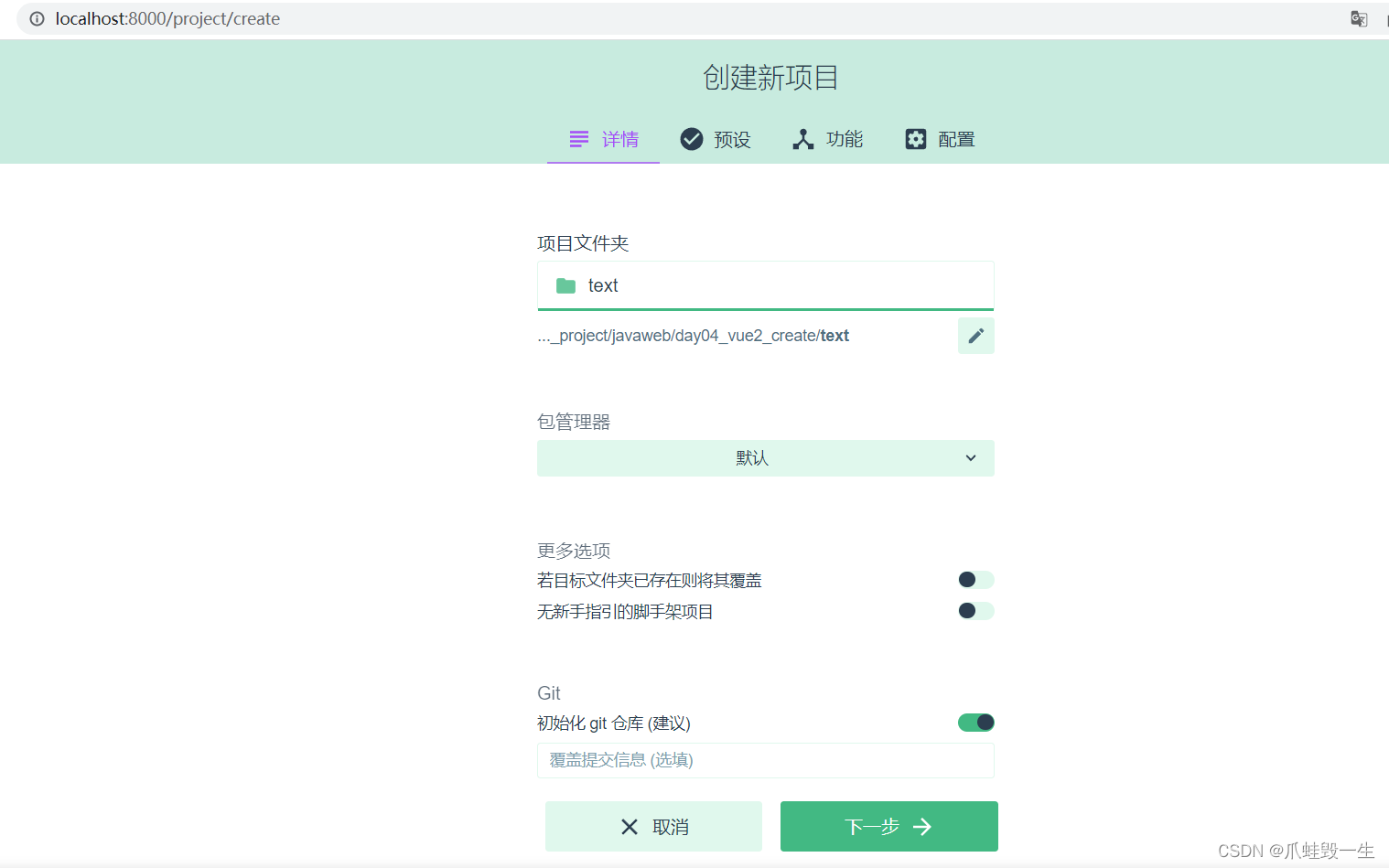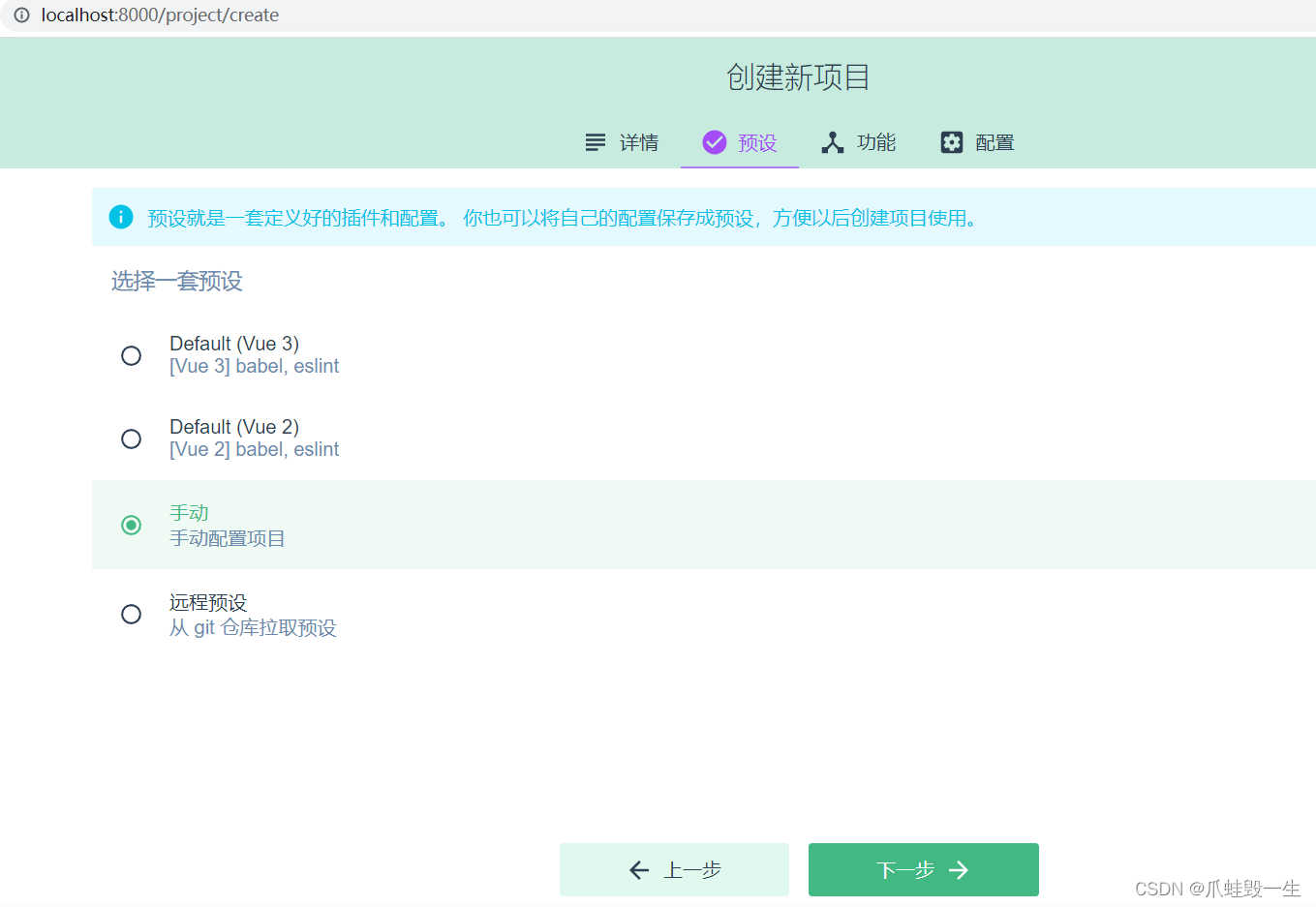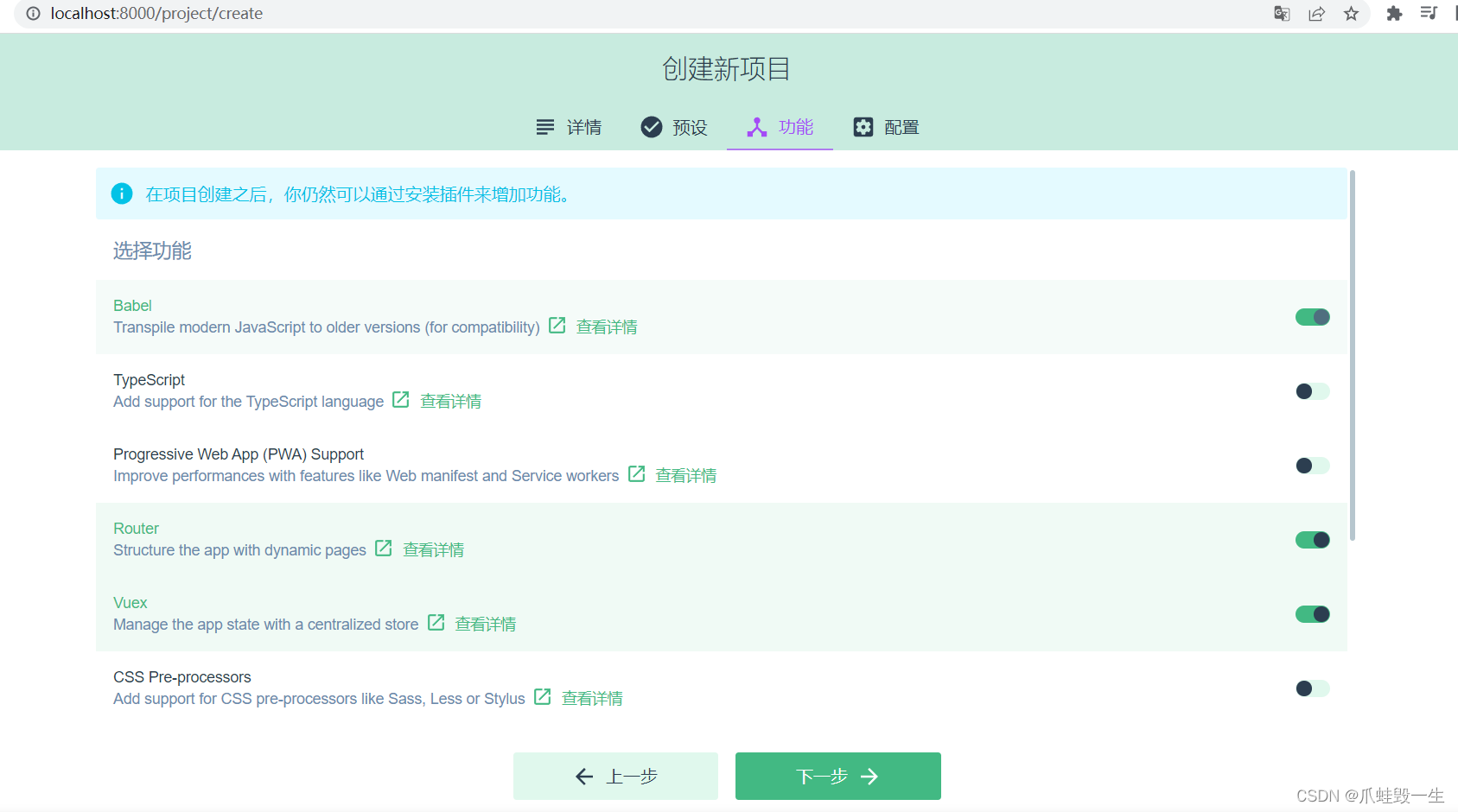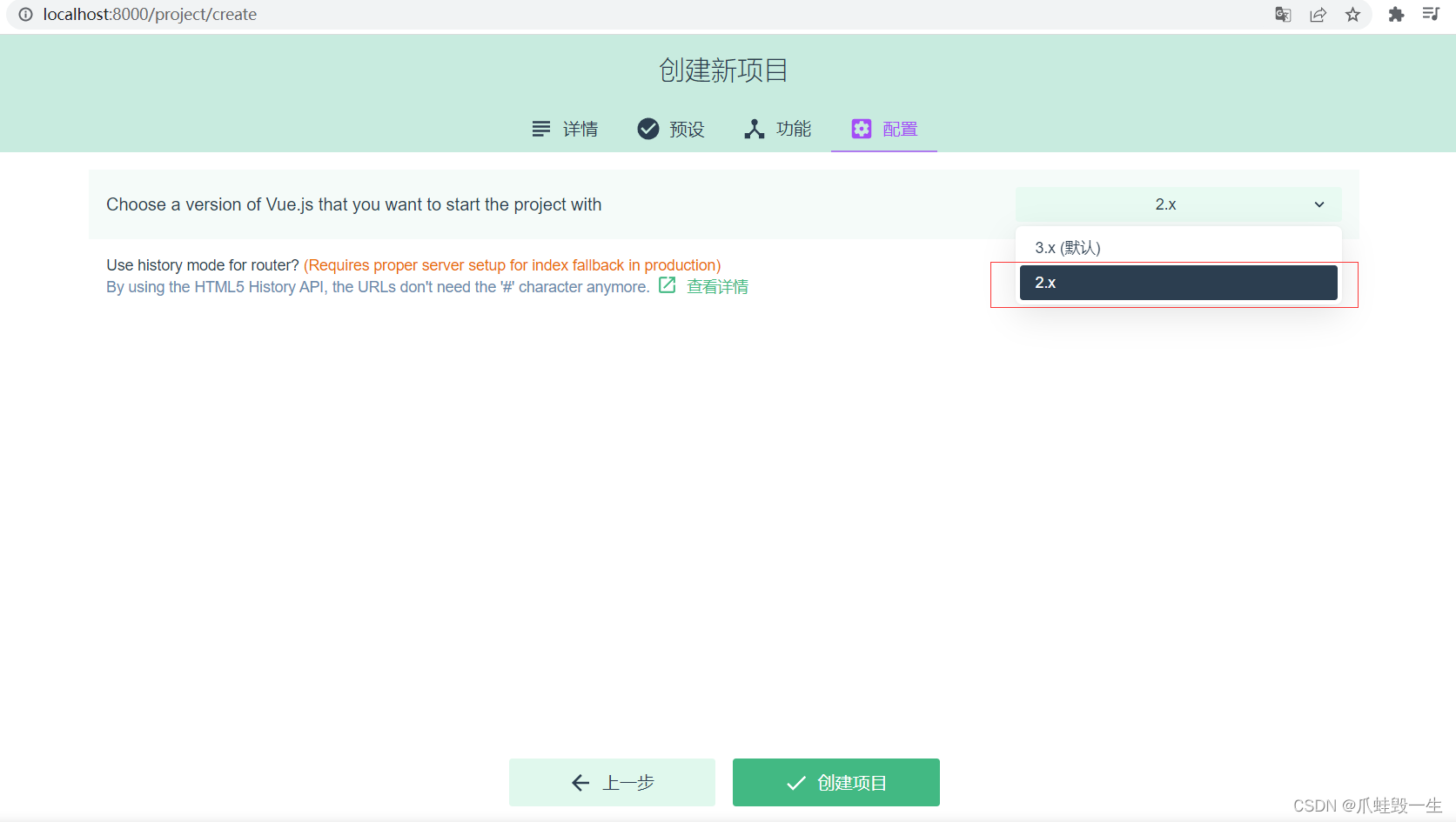java程序员学前端-Vue2篇

Vue 2
1. Vue 基础
1) 环境准备
安装脚手架
npm install -g @vue/cli
- -g 参数表示全局安装,这样在任意目录都可以使用 vue 脚本创建项目
创建项目
vue ui
使用图形向导来创建 vue 项目,如下图,输入项目名

选择手动配置项目

添加 vue router 和 vuex

选择版本,创建项目

安装 devtools
- devtools 插件网址:https://devtools.vuejs.org/guide/installation.html
运行项目
进入项目目录,执行
npm run serve
修改端口
前端服务器默认占用了 8080 端口,需要修改一下
-
文档地址:DevServer | webpack
-
打开 vue.config.js 添加
const { defineConfig } = require('@vue/cli-service') module.exports = defineConfig({// ...devServer: {port: 7070}})
添加代理
为了避免前后端服务器联调时, fetch、xhr 请求产生跨域问题,需要配置代理
-
文档地址同上
-
打开 vue.config.js 添加
const { defineConfig } = require('@vue/cli-service') module.exports = defineConfig({// ...devServer: {port: 7070,proxy: {'/api': {target: 'http://localhost:8080',changeOrigin: true}}}})
Vue 项目结构
PS D:\\2022.js\\代码\\第3章\\client> tree src
D:\\2022.JS\\代码\\第3章\\CLIENT\\SRC
├─assets
├─components
├─router
├─store
└─views
以后还会添加
- api - 跟后台交互,发送 fetch、xhr 请求,接收响应
- plugins - 插件
2) Vue 组件
Vue 的组件文件以 .vue 结尾,每个组件由三部分组成
<template></template><script></script><style></style>
- template 模板部分,由它生成 html 代码
- script 代码部分,控制模板的数据来源和行为
- style 样式部分,一般不咋关心
入口组件是 App.vue
先删除原有代码,来个 Hello, World 例子
<template><h1>{{msg}}</h1>
</template><script>
export default {data() {return {msg: "Hello, Vue!"}}
}
</script>
解释
- export default 导出组件对象,供 main.js 导入使用
- 这个对象有一个 data 方法,返回一个对象,给 template 提供数据
{{}}在 Vue 里称之为插值表达式,用来绑定 data 方法返回的对象属性,绑定的含义是数据发生变化时,页面显示会同步变化
文本插值
<template><div><h1>{{ name }}</h1><h1>{{ age > 60 ? '老年' : '青年' }}</h1></div>
</template>
<script>
const options = {data: function () {return { name: '张三', age: 70 };}
};
export default options;
</script>
{{}}里只能绑定一个属性,绑定多个属性需要用多个{{}}分别绑定- template 内只能有一个根元素
- 插值内可以进行简单的表达式计算
属性绑定
<template><div><div><input type="text" v-bind:value="name"></div><div><input type="date" v-bind:value="birthday"></div><div><input type="text" :value="age"></div></div>
</template>
<script>
const options = {data: function () {return { name: '王五', birthday: '1995-05-01', age: 20 };}
};
export default options;
</script>
- 简写方式:可以省略 v-bind 只保留冒号
事件绑定
<!-- 事件绑定 -->
<template><div><div><input type="button" value="点我执行m1" v-on:click="m1"></div><div><input type="button" value="点我执行m2" @click="m2"></div><div>{{count}}</div></div>
</template>
<script>
const options = {data: function () {return { count: 0 };},methods: {m1() {this.count ++;console.log("m1")},m2() {this.count --;console.log("m2")}}
};
export default options;
</script>
- 简写方式:可以把 v-on: 替换为 @
- 在 methods 方法中的 this 代表的是 data 函数返回的数据对象
双向绑定
<template><div><div><label for="">请输入姓名</label><input type="text" v-model="name"></div><div><label for="">请输入年龄</label><input type="text" v-model="age"></div><div><label for="">请选择性别</label>男 <input type="radio" value="男" v-model="sex">女 <input type="radio" value="女" v-model="sex"></div><div><label for="">请选择爱好</label>游泳 <input type="checkbox" value="游泳" v-model="fav">打球 <input type="checkbox" value="打球" v-model="fav">健身 <input type="checkbox" value="健身" v-model="fav"></div></div>
</template>
<script>
const options = {data: function () {return { name: '', age: null, sex:'男' , fav:['打球']};},methods: {}
};
export default options;
</script>
- 用 v-model 实现双向绑定,即
- javascript 数据可以同步到表单标签
- 反过来用户在表单标签输入的新值也会同步到 javascript 这边
- 双向绑定只适用于表单这种带【输入】功能的标签,其它标签的数据绑定,单向就足够了
- 复选框这种标签,双向绑定的 javascript 数据类型一般用数组
计算属性
<!-- 计算属性 -->
<template><div><h2>{{fullName}}</h2><h2>{{fullName}}</h2><h2>{{fullName}}</h2></div>
</template>
<script>
const options = {data: function () {return { firstName: '三', lastName: '张' };},/* methods: {fullName() {console.log('进入了 fullName')return this.lastName + this.firstName;}},*/computed: {fullName() {console.log('进入了 fullName')return this.lastName + this.firstName;}}
};
export default options;
- 普通方法调用必须加 (),没有缓存功能
- 计算属性使用时就把它当属性来用,不加 (),有缓存功能:
- 一次计算后,会将结果缓存,下次再计算时,只要数据没有变化,不会重新计算,直接返回缓存结果
axios
axios 它的底层是用了 XMLHttpRequest(xhr)方式发送请求和接收响应,xhr 相对于之前讲过的 fetch api 来说,功能更强大,但由于是比较老的 api,不支持 Promise,axios 对 xhr 进行了封装,使之支持 Promise,并提供了对请求、响应的统一拦截功能
安装
npm install axios -S
导入
import axios from 'axios'
- axios 默认导出一个对象,这里的 import 导入的就是它默认导出的对象
方法
| 请求 | 备注 |
|---|---|
| axios.get(url[, config]) | ⭐️ |
| axios.delete(url[, config]) | |
| axios.head(url[, config]) | |
| axios.options(url[, config]) | |
| axios.post(url[, data[, config]]) | ⭐️ |
| axios.put(url[, data[, config]]) | |
| axios.patch(url[, data[, config]]) |
- config - 选项对象、例如查询参数、请求头…
- data - 请求体数据、最常见的是 json 格式数据
- get、head 请求无法携带请求体,这应当是浏览器的限制所致(xhr、fetch api 均有限制)
- options、delete 请求可以通过 config 中的 data 携带请求体
例子
<template><div><input type="button" value="获取远程数据" @click="sendReq()"></div>
</template>
<script>
import axios from 'axios'
const options = {methods: {async sendReq() {// 1. 演示 get, post// const resp = await axios.post('/api/a2');// 2. 发送请求头// const resp = await axios.post('/api/a3',{},{// headers:{// Authorization:'abc'// }// });// 3. 发送请求时携带查询参数 ?name=xxx&age=xxx// const name = encodeURIComponent('&&&');// const age = 18;// const resp = await axios.post(`/api/a4?name=${name}&age=${age}`);// 不想自己拼串、处理特殊字符、就用下面的办法// const resp = await axios.post('/api/a4', {}, {// params: {// name:'&&&&',// age: 20// }// });// 4. 用请求体发数据,格式为 urlencoded// const params = new URLSearchParams();// params.append("name", "张三");// params.append("age", 24)// const resp = await axios.post('/api/a4', params);// 5. 用请求体发数据,格式为 multipart// const params = new FormData();// params.append("name", "李四");// params.append("age", 30);// const resp = await axios.post('/api/a5', params);// 6. 用请求体发数据,格式为 jsonconst resp = await axios.post('/api/a5json', {name: '王五',age: 50});console.log(resp);}}
};
export default options;
</script>
创建实例
const _axios = axios.create(config);
- axios 对象可以直接使用,但使用的是默认的设置
- 用 axios.create 创建的对象,可以覆盖默认设置,config 见下面说明
常见的 config 项有
| 名称 | 含义 |
|---|---|
| baseURL | 将自动加在 url 前面 |
| headers | 请求头,类型为简单对象 |
| params | 跟在 URL 后的请求参数,类型为简单对象或 URLSearchParams |
| data | 请求体,类型有简单对象、FormData、URLSearchParams、File 等 |
| withCredentials | 跨域时是否携带 Cookie 等凭证,默认为 false |
| responseType | 响应类型,默认为 json |
例
const _axios = axios.create({baseURL: 'http://localhost:8080',withCredentials: true
});
await _axios.post('/api/a6set')
await _axios.post('/api/a6get')
- 生产环境希望 xhr 请求不走代理,可以用 baseURL 统一修改
- 希望跨域请求携带 cookie,需要配置 withCredentials: true,服务器也要配置 allowCredentials = true,否则浏览器获取跨域返回的 cookie 时会报错
响应格式
| 名称 | 含义 |
|---|---|
| data | 响应体数据 ⭐️ |
| status | 状态码 ⭐️ |
| headers | 响应头 |
- 200 表示响应成功
- 400 请求数据不正确 age=abc
- 401 身份验证没通过
- 403 没有权限
- 404 资源不存在
- 405 不支持请求方式 post
- 500 服务器内部错误
请求拦截器
_axios.interceptors.request.use(function(config) {// 比如在这里添加统一的 headersreturn config;},function(error) {return Promise.reject(error);}
);
响应拦截器
_axios.interceptors.response.use(function(response) {// 2xx 范围内走这里return response;},function(error) {// 超出 2xx, 比如 4xx, 5xx 走这里return Promise.reject(error);}
);
条件渲染
<template><div><input type="button" value="获取远程数据" @click="sendReq()"><div class="title">学生列表</div><div class="thead"><div class="row bold"><div class="col">编号</div><div class="col">姓名</div><div class="col">性别</div><div class="col">年龄</div></div></div><div class="tbody"><div class="row" v-if="students.length > 0">显示学生数据</div><div class="row" v-else>暂无学生数据</div></div></div>
</template>
<script>
import axios from '../util/myaxios'
const options = {data: function() {return {students: []};},methods : {async sendReq() {const resp = await axios.get("/api/students");console.log(resp.data.data)this.students = resp.data.data;}}
};
export default options;
</script>
<style scoped>div {font-family: 华文行楷;font-size: 20px;}.title {margin-bottom: 10px;font-size: 30px;color: #333;text-align: center;}.row {background-color: #fff;display: flex;justify-content: center;}.col {border: 1px solid #f0f0f0;width: 15%;height: 35px;text-align: center;line-height: 35px;}.bold .col {background-color: #f1f1f1;}
</style>
列表渲染
<template><div><!-- <input type="button" value="获取远程数据" @click="sendReq()"> --><div class="title">学生列表</div><div class="thead"><div class="row bold"><div class="col">编号</div><div class="col">姓名</div><div class="col">性别</div><div class="col">年龄</div></div></div><div class="tbody"><div v-if="students.length > 0"><div class="row" v-for="s of students" :key="s.id"><div class="col">{{s.id}}</div><div class="col">{{s.name}}</div><div class="col">{{s.sex}}</div><div class="col">{{s.age}}</div></div></div><div class="row" v-else>暂无学生数据</div></div></div>
</template>
<script>
import axios from '../util/myaxios'
const options = {mounted: function(){this.sendReq()},data: function() {return {students: []};},methods : {async sendReq() {const resp = await axios.get("/api/students");console.log(resp.data.data)this.students = resp.data.data;}}
};
export default options;
</script>
<style scoped>div {font-family: 华文行楷;font-size: 20px;}.title {margin-bottom: 10px;font-size: 30px;color: #333;text-align: center;}.row {background-color: #fff;display: flex;justify-content: center;}.col {border: 1px solid #f0f0f0;width: 15%;height: 35px;text-align: center;line-height: 35px;}.bold .col {background-color: #f1f1f1;}
</style>
- v-if 和 v-for 不能用于同一个标签
- v-for 需要配合特殊的标签属性 key 一起使用,并且 key 属性要绑定到一个能起到唯一标识作用的数据上,本例绑定到了学生编号上
- options 的 mounted 属性对应一个函数,此函数会在组件挂载后(准备就绪)被调用,可以在它内部发起请求,去获取学生数据
重用组件
按钮组件
<template><div class="button" :class="[type,size]">a<slot></slot>b</div>
</template>
<script>
const options = {props: ["type", "size"]
};
export default options;
</script>
- 注意,省略了样式部分
使用组件
<template><div><h1>父组件</h1><my-button type="primary" size="small">1</my-button><my-button type="danger" size="middle">2</my-button><my-button type="success" size="large">3</my-button></div>
</template>
<script>
import MyButton from '../components/MyButton.vue'
const options = {components: {MyButton}
};
export default options;
</script>
2. Vue 进阶
1) ElementUI
安装
npm install element-ui -S
引入组件
import Element from 'element-ui'
import 'element-ui/lib/theme-chalk/index.css'Vue.use(Element)
测试,在自己的组件中使用 ElementUI 的组件
<el-button>按钮</el-button>
表格组件
<template><div><el-table :data="students"><el-table-column label="编号" prop="id"></el-table-column><el-table-column label="姓名" prop="name"></el-table-column><el-table-column label="性别" prop="sex"></el-table-column><el-table-column label="年龄" prop="age"></el-table-column></el-table></div>
</template>
<script>
import axios from '../util/myaxios'
const options = {async mounted() {const resp = await axios.get('/api/students');this.students = resp.data.data},data() {return {students: []}}
}
export default options;
</script>
分页组件
<template><div><el-table v-bind:data="students"><el-table-column label="编号" prop="id"></el-table-column><el-table-column label="姓名" prop="name"></el-table-column><el-table-column label="性别" prop="sex"></el-table-column><el-table-column label="年龄" prop="age"></el-table-column></el-table><el-pagination :total="total":page-size="queryDto.size":current-page="queryDto.page"layout="prev,pager,next,sizes,->,total":page-sizes="[5,10,15,20]"@current-change="currentChange"@size-change="sizeChange"></el-pagination></div>
</template>
<script>
import axios from '../util/myaxios'
const options = {mounted() {this.query();},methods: {currentChange(page) {this.queryDto.page = page;this.query();},sizeChange(size){this.queryDto.size = size;this.query();},async query() {const resp = await axios.get('/api/students/q', {params: this.queryDto});this.students = resp.data.data.list;this.total = resp.data.data.total;}},data() {return {students: [],total: 0,queryDto: {page: 1,size: 5}}}
}
export default options;
</script>
- 三种情况都应该触发查询
- mounted 组件挂载完成后
- 页号变化时
- 页大小变化时
- 查询传参应该根据后台需求,灵活采用不同方式
- 本例中因为是 get 请求,无法采用请求体,只能用 params 方式传参
- 返回响应的格式也许会很复杂,需要掌握【根据返回的响应结构,获取数据】的能力
分页搜索
<template><div><el-input placeholder="请输入姓名" size="mini" v-model="queryDto.name"></el-input><el-select placeholder="请选择性别" size="mini" v-model="queryDto.sex" clearable><el-option value="男"></el-option><el-option value="女"></el-option></el-select><el-select placeholder="请选择年龄" size="mini" v-model="queryDto.age" clearable><el-option value="0,20" label="0到20岁"></el-option><el-option value="21,30" label="21到30岁"></el-option><el-option value="31,40" label="31到40岁"></el-option><el-option value="41,120" label="41到120岁"></el-option></el-select><el-button type="primary" size="mini" @click="search()">搜索</el-button><el-divider></el-divider><el-table v-bind:data="students"><el-table-column label="编号" prop="id"></el-table-column><el-table-column label="姓名" prop="name"></el-table-column><el-table-column label="性别" prop="sex"></el-table-column><el-table-column label="年龄" prop="age"></el-table-column></el-table><el-pagination :total="total" :page-size="queryDto.size" :current-page="queryDto.page"layout="prev,pager,next,sizes,->,total" :page-sizes="[5, 10, 15, 20]" @current-change="currentChange"@size-change="sizeChange"></el-pagination></div>
</template>
<script>
import axios from '../util/myaxios'
const options = {mounted() {this.query();},methods: {currentChange(page) {this.queryDto.page = page;this.query();},sizeChange(size) {this.queryDto.size = size;this.query();},async query() {const resp = await axios.get('/api/students/q', {params: this.queryDto});this.students = resp.data.data.list;this.total = resp.data.data.total;},search() {this.query();}},data() {return {students: [],total: 0,queryDto: {name: '',sex: '',age: '', page: 1,size: 5}}}
}
export default options;
</script>
- sex 与 age 均用
''表示用户没有选择的情况 - age 取值
0,20会被 spring 转换为new int[]{0, 20} - age 取值
''会被 spring 转换为new int[0]
级联选择
级联选择器中选项的数据结构为
[{value:100, label:'主页',children:[{value:101, label:'菜单1', children:[{value:105, label:'子项1'},{value:106, label:'子项2'}]},{value:102, label:'菜单2', children:[{value:107, label:'子项3'},{value:108, label:'子项4'},{value:109, label:'子项5'}]},{value:103, label:'菜单3', children:[{value:110, label:'子项6'},{value:111, label:'子项7'}]},{value:104, label:'菜单4'}]}
]
下面的例子是将后端返回的一维数组【树化】
<template><el-cascader :options="ops"></el-cascader>
</template>
<script>
import axios from '../util/myaxios'
const options = {async mounted() {const resp = await axios.get('/api/menu')console.log(resp.data.data)const array = resp.data.data;const map = new Map(); // 1. 将所有数据存入 map 集合(为了接下来查找效率)for(const {id,name,pid} of array) {map.set(id, {value:id, label:name, pid:pid})}// 2. 建立父子关系// 3. 找到顶层对象const top = [];for(const obj of map.values()) {const parent = map.get(obj.pid);if(parent !== undefined) {parent.children ??= [];parent.children.push(obj);} else {top.push(obj)}}this.ops = top;},data(){return {ops: []}}
};
export default options;
</script>
2) Vue-Router
vue 属于单页面应用,所谓的路由,就是根据浏览器路径不同,用不同的视图组件替换这个页面内容展示
配置路由
新建一个路由 js 文件,例如 src/router/example14.js,内容如下
import Vue from 'vue'
import VueRouter from 'vue-router'
import ContainerView from '@/views/example14/ContainerView.vue'
import LoginView from '@/views/example14/LoginView.vue'
import NotFoundView from '@/views/example14/NotFoundView.vue'Vue.use(VueRouter)const routes = [{path:'/',component: ContainerView},{path:'/login',component: LoginView},{path:'/404',component: NotFoundView}
]const router = new VueRouter({routes
})export default router
- 最重要的就是建立了【路径】与【视图组件】之间的映射关系
- 本例中映射了 3 个路径与对应的视图组件
在 main.js 中采用我们的路由 js
import Vue from 'vue'
import e14 from './views/Example14View.vue'
import router from './router/example14' // 修改这里
import store from './store'
import Element from 'element-ui'
import 'element-ui/lib/theme-chalk/index.css'Vue.config.productionTip = falseVue.use(Element)
new Vue({router,store,render: h => h(e14)
}).$mount('#app')
根组件是 Example14View.vue,内容为:
<template><div class="all"><router-view></router-view></div>
</template>
- 样式略
- 其中
<router-view>起到占位作用,改变路径后,这个路径对应的视图组件就会占据<router-view>的位置,替换掉它之前的内容
动态导入
import Vue from 'vue'
import VueRouter from 'vue-router'Vue.use(VueRouter)const routes = [{path:'/',component: () => import('@/views/example14/ContainerView.vue')},{path:'/login',component: () => import('@/views/example14/LoginView.vue')},{path:'/404',component: () => import('@/views/example14/NotFoundView.vue')}
]const router = new VueRouter({routes
})export default router
- 静态导入是将所有组件的 js 代码打包到一起,如果组件非常多,打包后的 js 文件会很大,影响页面加载速度
- 动态导入是将组件的 js 代码放入独立的文件,用到时才加载
嵌套路由
组件内再要切换内容,就需要用到嵌套路由(子路由),下面的例子是在【ContainerView 组件】内定义了 3 个子路由
const routes = [{path:'/',component: () => import('@/views/example14/ContainerView.vue'),redirect: '/c/p1',children: [{ path:'c/p1',component: () => import('@/views/example14/container/P1View.vue')},{ path:'c/p2',component: () => import('@/views/example14/container/P2View.vue')},{ path:'c/p3',component: () => import('@/views/example14/container/P3View.vue')}]},{path:'/login',component: () => import('@/views/example14/LoginView.vue')},{path:'/404',component: () => import('@/views/example14/NotFoundView.vue')},{path:'*',redirect: '/404'}
]
子路由变化,切换的是【ContainerView 组件】中 <router-view></router-view> 部分的内容
<template><div class="container"><router-view></router-view></div>
</template>
- redirect 可以用来重定向(跳转)到一个新的地址
- path 的取值为 * 表示匹配不到其它 path 时,就会匹配它
ElementUI 布局
通常主页要做布局,下面的代码是 ElementUI 提供的【上-【左-右】】布局
<template><div class="container"><el-container><el-header></el-header><el-container><el-aside width="200px"></el-aside><el-main><router-view></router-view></el-main></el-container></el-container></div>
</template>
路由跳转
标签式
<el-aside width="200px"><router-link to="/c1/p1">P1</router-link><router-link to="/c1/p2">P2</router-link><router-link to="/c1/p3">P3</router-link>
</el-aside>
编程式
<el-header><el-button type="primary" icon="el-icon-edit" circle size="mini" @click="jump('/c1/p1')"></el-button><el-button type="success" icon="el-icon-check" circle size="mini" @click="jump('/c1/p2')"></el-button><el-button type="warning" icon="el-icon-star-off" circle size="mini" @click="jump('/c1/p3')"></el-button>
</el-header>
jump 方法
<script>
const options = {methods : {jump(url) {this.$router.push(url);}}
}
export default options;
</script>
- 其中 this.$router 是拿到路由对象
- push 方法根据 url 进行跳转
导航菜单
<el-menu router background-color="#545c64" text-color="#fff" active-text-color="#ffd04b"><el-submenu index="/c1"><span slot="title"><i class="el-icon-platform-eleme"></i>菜单1</span><el-menu-item index="/c1/p1">子项1</el-menu-item><el-menu-item index="/c1/p2">子项2</el-menu-item><el-menu-item index="/c1/p3">子项3</el-menu-item></el-submenu><el-menu-item index="/c2"><span slot="title"><i class="el-icon-phone"></i>菜单2</span></el-menu-item><el-menu-item index="/c3"><span slot="title"><i class="el-icon-star-on"></i>菜单3</span></el-menu-item>
</el-menu>
- 图标和菜单项文字建议用
<span slot='title'></span>包裹起来 el-menu标签上加上router属性,表示结合导航菜单与路由对象,此时,就可以利用菜单项的index属性来路由跳转
动态路由与菜单
将菜单、路由信息(仅主页的)存入数据库中
insert into menu(id, name, pid, path, component, icon) values(101, '菜单1', 0, '/m1', null, 'el-icon-platform-eleme'),(102, '菜单2', 0, '/m2', null, 'el-icon-delete-solid'),(103, '菜单3', 0, '/m3', null, 'el-icon-s-tools'),(104, '菜单4', 0, '/m4', 'M4View.vue', 'el-icon-user-solid'),(105, '子项1', 101, '/m1/c1', 'C1View.vue', 'el-icon-s-goods'),(106, '子项2', 101, '/m1/c2', 'C2View.vue', 'el-icon-menu'),(107, '子项3', 102, '/m2/c3', 'C3View.vue', 'el-icon-s-marketing'),(108, '子项4', 102, '/m2/c4', 'C4View.vue', 'el-icon-s-platform'),(109, '子项5', 102, '/m2/c5', 'C5View.vue', 'el-icon-picture'),(110, '子项6', 103, '/m3/c6', 'C6View.vue', 'el-icon-upload'),(111, '子项7', 103, '/m3/c7', 'C7View.vue', 'el-icon-s-promotion');
不同的用户查询的的菜单、路由信息是不一样的
例如:访问 /api/menu/admin 返回所有的数据
[{"id": 102,"name": "菜单2","icon": "el-icon-delete-solid","path": "/m2","pid": 0,"component": null},{"id": 107,"name": "子项3","icon": "el-icon-s-marketing","path": "/m2/c3","pid": 102,"component": "C3View.vue"},{"id": 108,"name": "子项4","icon": "el-icon-s-platform","path": "/m2/c4","pid": 102,"component": "C4View.vue"},{"id": 109,"name": "子项5","icon": "el-icon-picture","path": "/m2/c5","pid": 102,"component": "C5View.vue"}
]
访问 /api/menu/wang 返回
[{"id": 103,"name": "菜单3","icon": "el-icon-s-tools","path": "/m3","pid": 0,"component": null},{"id": 110,"name": "子项6","icon": "el-icon-upload","path": "/m3/c6","pid": 103,"component": "C6View.vue"},{"id": 111,"name": "子项7","icon": "el-icon-s-promotion","path": "/m3/c7","pid": 103,"component": "C7View.vue"}
]
前端根据他们身份不同,动态添加路由和显示菜单
动态路由
export function addServerRoutes(array) {for (const { id, path, component } of array) {if (component !== null) {// 动态添加路由// 参数1:父路由名称// 参数2:路由信息对象router.addRoute('c', {path: path,name: id,component: () => import(`@/views/example15/container/${component}`)});}}
}
- js 这边只保留几个固定路由,如主页、404 和 login
- 以上方法执行时,将服务器返回的路由信息加入到名为 c 的父路由中去
- 这里要注意组件路径,前面 @/views 是必须在 js 这边完成拼接的,否则 import 函数会失效
重置路由
在用户注销时应当重置路由
export function resetRouter() {router.matcher = new VueRouter({ routes }).matcher
}
页面刷新
页面刷新后,会导致动态添加的路由失效,解决方法是将路由数据存入 sessionStorage
<script>
import axios from '@/util/myaxios'
import {resetRouter, addServerRoutes} from '@/router/example15'
const options = {data() {return {username: 'admin'}},methods: {async login() { resetRouter(); // 重置路由 const resp = await axios.get(`/api/menu/${this.username}`)const array = resp.data.data;// localStorage 即使浏览器关闭,存储的数据仍在// sessionStorage 以标签页为单位,关闭标签页时,数据被清除sessionStorage.setItem('serverRoutes', JSON.stringify(array))addServerRoutes(array); // 动态添加路由this.$router.push('/');}}
}
export default options;
</script>
页面刷新,重新创建路由对象时,从 sessionStorage 里恢复路由数据
const router = new VueRouter({routes
})// 从 sessionStorage 中恢复路由数据
const serverRoutes = sessionStorage.getItem('serverRoutes');
if(serverRoutes) {const array = JSON.parse(serverRoutes);addServerRoutes(array) // 动态添加路由
}
动态菜单
代码部分
<script>
const options = {mounted() {const serverRoutes = sessionStorage.getItem('serverRoutes');const array = JSON.parse(serverRoutes);const map = new Map();for(const obj of array) {map.set(obj.id, obj);}const top = [];for(const obj of array) {const parent = map.get(obj.pid);if(parent) {parent.children ??= [];parent.children.push(obj);} else {top.push(obj);}}this.top = top;},data() {return {top: []}}
}
export default options;
</script>
菜单部分
<el-menu router background-color="#545c64" text-color="#fff" active-text-color="#ffd04b" :unique-opened="true"><template v-for="m1 of top">
<el-submenu v-if="m1.children" :key="m1.id" :index="m1.path"><span slot="title"><i :class="m1.icon"></i> {{m1.name}}</span><el-menu-item v-for="m2 of m1.children" :key="m2.id" :index="m2.path"><span slot="title"><i :class="m2.icon"></i> {{m2.name}}</span></el-menu-item></el-submenu>
<el-menu-item v-else :key="m1.id" :index="m1.path"><span slot="title"><i :class="m1.icon"></i> {{m1.name}}</span></el-menu-item></template>
</el-menu>
- 没有考虑递归菜单问题,认为菜单只有两级
3) Vuex
入门
vuex 可以在多个组件之间共享数据,并且共享的数据是【响应式】的,即数据的变更能及时渲染到模板
- 与之对比 localStorage 与 sessionStorage 也能共享数据,但缺点是数据并非【响应式】
首先需要定义 state 与 mutations 他们一个用来读取共享数据,一个用来修改共享数据
src/store/index.js
import Vue from 'vue'
import Vuex from 'vuex'Vue.use(Vuex)/*读取数据,走 state, getters修改数据,走 mutations, actions
*/
export default new Vuex.Store({state: {name: '',age: 18},getters: {},mutations: {updateName(state, name) {state.name = name;}},actions: {},modules: {}
})
修改共享数据
<template><div class="p"><el-input placeholder="请修改用户姓名" size="mini" v-model="name"></el-input><el-button type="primary" size="mini" @click="update()">修改</el-button></div>
</template>
<script>
const options = {methods: {update(){this.$store.commit('updateName', this.name);}},data () {return {name:''}}
}
export default options;
</script>
- mutations 方法不能直接调用,只能通过
store.commit(mutation方法名, 参数)来间接调用
读取共享数据
<template><div class="container"><el-container><el-header><div class="t">欢迎您:{{ $store.state.name }}, {{ $store.state.age }}</div></el-header><el-container><el-aside width="200px"></el-aside><el-main><router-view></router-view></el-main></el-container></el-container></div>
</template>
mapState
每次去写 $store.state.name 这样的代码显得非常繁琐,可以用 vuex 帮我们生成计算属性
<template><div class="container"><el-container><el-header><div class="t">欢迎您:{{ name }}, {{ age }}</div></el-header><el-container><el-aside width="200px"></el-aside><el-main><router-view></router-view></el-main></el-container></el-container></div>
</template>
<script>
import { mapState } from 'vuex'
const options = {computed: {...mapState(['name', 'age'])}
}
export default options;
</script>
- mapState 返回的是一个对象,对象内包含了 name() 和 age() 的这两个方法作为计算属性
- 此对象配合
...展开运算符,填充入 computed 即可使用
mapMutations
<template><div class="p"><el-input placeholder="请修改用户姓名" size="mini" v-model="name"></el-input><el-button type="primary" size="mini" @click="updateName(name)">修改</el-button></div>
</template>
<script>
import {mapMutations} from 'vuex'
const options = {methods: {...mapMutations(['updateName'])},data () {return {name:''}}
}
export default options;
</script>
- 类似的,调用 mutation 修改共享数据也可以简化
- mapMutations 返回的对象中包含的方法,就会调用 store.commit() 来执行 mutation 方法
- 注意参数传递略有不同
actions
mutations 方法内不能包括修改不能立刻生效的代码,否则会造成 Vuex 调试工具工作不准确,必须把这些代码写在 actions 方法中
import Vue from 'vue'
import Vuex from 'vuex'Vue.use(Vuex)/*读取数据,走 state, getters修改数据,走 mutations, actions
*/
import axios from '@/util/myaxios'
export default new Vuex.Store({state: {name: '',age: 18},getters: {},mutations: {updateName(state, name) {state.name = name;},// 错误的用法,如果在mutations方法中包含了异步操作,会造成开发工具不准确/* async updateServerName(state) {const resp = await axios.get('/api/user');const {name, age} = resp.data.data;state.name = name;state.age = age;} */updateServerName(state, user) {const { name, age } = user;state.name = name;state.age = age;}},actions: {async updateServerName(context) {const resp = await axios.get('/api/user');context.commit('updateServerName', resp.data.data)}},modules: {}
})
- 首先应当调用 actions 的 updateServerName 获取数据
- 然后再由它间接调用 mutations 的 updateServerName 更新共享数据
页面使用 actions 的方法可以这么写
<template><div class="p"><el-button type="primary" size="mini"@click="updateServerName()">从服务器获取数据,存入store</el-button></div>
</template>
<script>
import { mapActions } from 'vuex'
const options = {methods: {...mapActions(['updateServerName'])}
}
export default options;
</script>
-
mapActions 会生成调用 actions 中方法的代码
-
调用 actions 的代码内部等价于,它返回的是 Promise 对象,可以用同步或异步方式接收结果
this.$store.dispatch('action名称', 参数)
3. Vue 实战
课程不准备从头开发一个 Vue 项目,这里我准备采用这样的教学方法:带着大家看一个较为典型的基于 Vue 的项目实现,分析其中几个重点流程
这里选择了 vue-element-admin 这个项目骨架,它采用的技术与我们之前学过的较为契合
- vue 2
- element-ui 2
- vue-router 3
- vuex 3
- axios
安装
git clone https://gitee.com/panjiachen/vue-element-admin.git client-actioncd client-actiongit branch -agit checkout -b i18n remotes/origin/i18ngit config --global url."https://".insteadOf git://npm installnpm run dev
- 需要切换分支到 i18n,否则不支持国际化(中文)功能
- npm install 要多试几次,因为中间会连接 gitbub 下载一些依赖,网络不稳定会导致失败
- npm run dev 运行后回自动打开浏览器,使用的端口是 9527
后端路径
开发环境下执行下面命令
npm run dev
- 会同时启动 mock-server
在开发环境下,后端访问路径起始路径配置在文件 .env.development 中
VUE_APP_BASE_API = '/dev-api'
- 默认向后台的请求都发给
http://localhost:9527/dev-api的 mock-server 获得的都是模拟数据 - 需要跟真实后台联调时,可以改动以上地址为
VUE_APP_BASE_API = 'http://localhost:8080/api'
发送请求的 axios 工具被封装在 src/utils/request.js 中
import axios from 'axios'
import { MessageBox, Message } from 'element-ui'
import store from '@/store'
import { getToken } from '@/utils/auth'// create an axios instance
const service = axios.create({baseURL: process.env.VUE_APP_BASE_API, // url = base url + request url// withCredentials: true, // send cookies when cross-domain requeststimeout: 5000 // request timeout
})// ...
原有代码的 URI 路径都是这样的:
/vue-element-admin/user/login
/vue-element-admin/user/info
/vue-element-admin/user/logout
...
如果觉得不爽,可以来一个全局替换
/user/login
/user/info
/user/logout
...
token 的请求头修改一下,在 src/utils/request.js 中
...
service.interceptors.request.use(config => {// do something before request is sentif (store.getters.token) {// let each request carry token// ['X-Token'] is a custom headers key// please modify it according to the actual situationconfig.headers['Authorization'] = getToken()}return config},error => {// do something with request errorconsole.log(error) // for debugreturn Promise.reject(error)}
)
...
登录流程
1. src/views/login/index.vue
<script>
import { validUsername } from '@/utils/validate'
import LangSelect from '@/components/LangSelect'
import SocialSign from './components/SocialSignin'export default {// ...methods: { handleLogin() {this.$refs.loginForm.validate(valid => {if (valid) {this.loading = truethis.$store.dispatch('user/login', this.loginForm).then(() => {this.$router.push({ path: this.redirect || '/', query: this.otherQuery })this.loading = false}).catch(() => {this.loading = false})} else {console.log('error submit!!')return false}})}// ...}
}
</script>
这里调用了 store 的 actions,user/login
- 因为是异步调用,因此只能用 actions
- 登录成功会优先跳转至 this.redirect 路径、否则跳转至 /
- / 查看
src/router/index.js的路由表可知,会重定向至 /dashboard
2. src/store/modules/user.js
import { login, logout, getInfo } from '@/api/user'
// ...
const actions = {// user loginlogin({ commit }, userInfo) {const { username, password } = userInforeturn new Promise((resolve, reject) => {login({ username: username.trim(), password: password }).then(response => {const { data } = responsecommit('SET_TOKEN', data.token)setToken(data.token)resolve()}).catch(error => {reject(error)})})}// ...
}
- 发请求用了
src/api/user.js,请求成功使用 commit 将 token 存入 mutations,同时往 cookie 存储了一份 - 这里的 response 其实是真正的 response.data,见后面的说明
- 评价
- 向 cookie 或 sessionStorage 存储 token 即可,token 无需做成响应式,不必放入 store
- 作者使用了 Promise API,其实可以改变为 await 方式,提高可读性
3. src/api/user.js
import request from '@/utils/request'export function login(data) {return request({url: '/user/login',method: 'post',data})
}// ...
- 其中 request 相当于我们之前封装的 myaxios
4. src/utils/request.js
import axios from 'axios'
import { MessageBox, Message } from 'element-ui'
import store from '@/store'
import { getToken } from '@/utils/auth'// create an axios instance
const service = axios.create({baseURL: process.env.VUE_APP_BASE_API, // url = base url + request url// withCredentials: true, // send cookies when cross-domain requeststimeout: 5000 // request timeout
})// ... service.interceptors.response.use(// ...response => {const res = response.dataif (res.code !== 20000) {// ...} else {return res}},error => {// ...}
)export default service
- 其中响应拦截器发现响应正确,返回 resp.data 这样,其它处代码解构时少了一层 data
5. src/permission.js
登录成功后,只是获得了 token,还未获取用户信息,获取用户信息是在路由跳转的 beforeEach 里做的
关键代码
import router from './router'// ...router.beforeEach(async(to, from, next) => {// ...const hasToken = getToken()if (hasToken) {if (to.path === '/login') {// ...} else {// ...const { roles } = await store.dispatch('user/getInfo')// ...}} else {// ...}
})
- 登录后跳转至 / 之前进入这里的 beforeEach 方法,方法内主要做两件事
- 一是调用 actions 方法获取用户角色,见 6
- 二是根据用户角色,动态生成路由,见 7
6. src/store/modules/user.js
这里用其中 getInfo 方法获取用户信息,其中角色返回给 beforeEach
import { login, logout, getInfo } from '@/api/user'
// ...
const actions = {getInfo({ commit, state }) {return new Promise((resolve, reject) => {getInfo(state.token).then(response => {const { data } = responseif (!data) {reject('Verification failed, please Login again.')}const { roles, name, avatar, introduction } = dataif (!roles || roles.length <= 0) {reject('getInfo: roles must be a non-null array!')}commit('SET_ROLES', roles)commit('SET_NAME', name)commit('SET_AVATAR', avatar)commit('SET_INTRODUCTION', introduction)resolve(data)}).catch(error => {reject(error)})})}
}
7. src/router/index.js
路由表中路由分成两部分,静态路由与动态路由
export const constantRoutes = [// ...{path: '/login',component: () => import('@/views/login/index'),hidden: true},{path: '/',component: Layout,redirect: '/dashboard',children: [{path: 'dashboard',component: () => import('@/views/dashboard/index'),name: 'Dashboard',meta: { title: 'dashboard', icon: 'dashboard', affix: true }}]}// ...
]
- 其中 hidden: true 的路由只做路由跳转,不会在左侧导航菜单展示
动态路由
export const asyncRoutes = [{path: '/permission',component: Layout,redirect: '/permission/page',alwaysShow: true, // will always show the root menuname: 'Permission',meta: {title: 'permission',icon: 'lock',roles: ['admin', 'editor'] // you can set roles in root nav},children: [{path: 'page',component: () => import('@/views/permission/page'),name: 'PagePermission',meta: {title: 'pagePermission',roles: ['admin'] // or you can only set roles in sub nav}},{path: 'directive',component: () => import('@/views/permission/directive'),name: 'DirectivePermission',meta: {title: 'directivePermission'// if do not set roles, means: this page does not require permission}},{path: 'role',component: () => import('@/views/permission/role'),name: 'RolePermission',meta: {title: 'rolePermission',roles: ['admin']}}]},{path: '/icon',component: Layout,children: [{path: 'index',component: () => import('@/views/icons/index'),name: 'Icons',meta: { title: 'icons', icon: 'icon', noCache: true, roles: ['admin'] }}]}// ...
}
- 动态路由中关联了角色信息,根据用户的角色决定那些路由可用,但这样做的缺点是把角色和路由绑定死了
8. src/layout/index.vue
它对应的是我们之前介绍的 Container.vue 完成主页布局的,路由路径是 /
[外链图片转存失败,源站可能有防盗链机制,建议将图片保存下来直接上传(img-g3g2YSKr-1681398429528)(D:\\2022.js\\imgs\\image-20220827194047788.png)]
其中又由多部分组成,其中固定不变的是
- 侧边栏
- 导航栏
- 标签栏
- 设置
变化的是中间的 dashboard 部分(AppMain),它由 router-view 配合子路由切换显示
- 进入 / 后,就会 redirect 重定向到 /dashboard 子路由
- 进入首页后,会有一个
/api/transaction/list的后台请求报 404,作为练习,把它补充完整
第三方登录
-
9527 打开新窗口,请求
https://gitee.com/oauth/authorize?client_id=${client_id}&redirect_uri=${redirect_uri}&response_type=code -
gitee 认证通过,重定向至 8080,并携带 code
-
8080 发送请求
https://gitee.com/oauth/token携带 client_id、client_secret、code,gitee 返回 access_token 给 8080-
这时走的是 https 协议,并且不经过浏览器,能够保证数据传输的安全性
-
重定向到 8080 时,如果被有心人拿到了 code,也没事,因为接下来会把 client_secret 发给 gitee 验证(client_secret 应当只存在 8080),只要 client_secret 不泄露,就可以保证安全
-
如果改成前端拿 code 换 access_token,那就意味着 access_token 得保存在前端,所有保存在前端的都有风险
-
-
8080 可以访问 gitee 的 api 了,拿到用户信息,存入数据库,返回 8080 的 token
-
8080 可以通过 window.opener.postMessage 把 token 给 9527 的老窗口
- 这里又会涉及到跨域,不过 9527 与 8080 直接存在信任关系,设置一下就好
-
9527 再走之前的逻辑就可以了,在 router 的 beforeEach 方法里,用 8080 token 换用户信息
增删改查
首先,在 api 里添加与后端交互的代码:src/api/student.js
import axios from '@/utils/request'export function all() {return axios({url: '/students',method: 'get'})
}export function deleteById(id) {return axios({url: `/students/${id}`,method: 'delete'})
}export function update(id, dto) {return axios({url: `/students/${id}`,method: 'put',data: dto})
}export function insert(dto) {return axios({url: `/students`,method: 'post',data: dto})
}
然后,添加新的路由:src/router/index.js
export const asyncRoutes = [// ...{path: '/student',component: Layout,children: [{path: 'index',component: () => import('@/views/student/index'),meta: { title: '学生管理', icon: 'el-icon-s-help', roles: ['admin'] }}]},// ...
]
- 注意 title 这里没有考虑国际化
最后,添加新的视图界面:src/views/student/index.vue
<template><div><el-table :data="students"><el-table-column label="编号" prop="id"></el-table-column><el-table-column label="姓名" prop="name"></el-table-column><el-table-column label="性别" prop="sex"></el-table-column><el-table-column label="年龄" prop="age"></el-table-column><el-table-column fixed="right" label="操作" width="100"><template slot-scope="scope"><el-button @click="handleUpdate(scope.row)" type="text" size="small">修改</el-button><el-button @click="handleDelete(scope.row)" type="text" size="small">删除</el-button></template></el-table-column></el-table><el-dialog width="22%" :visible.sync="updateDialogVisible"><el-form :model="updateForm"><el-form-item label="编号"><el-input size="mini" :readonly="true" v-model="updateForm.id"></el-input></el-form-item><el-form-item label="姓名"><el-input size="mini" v-model="updateForm.name"></el-input></el-form-item><el-form-item label="性别"><el-select size="mini" v-model="updateForm.sex"><el-option value="男"></el-option><el-option value="女"></el-option></el-select></el-form-item><el-form-item label="年龄"><el-input size="mini" v-model="updateForm.age"></el-input></el-form-item><el-form-item><el-button type="primary" size="mini" @click="confirmUpdate()">确定</el-button></el-form-item></el-form></el-dialog></div>
</template>
<script>
import { all, deleteById, update, insert } from '@/api/student'
const options = {mounted() {this.all()},data() {return {students: [],updateDialogVisible: false,updateForm: {id: 0,name: '',sex: '男',age: 0}}},methods: {async confirmUpdate() {await update(this.updateForm.id, this.updateForm)this.updateDialogVisible = falsethis.all()},handleUpdate(row) { // {id, name, sex, age}this.updateDialogVisible = truethis.updateForm = { ...row }// this.updateForm = row // 错误写法,不能让他俩指向同一个对象},async handleDelete(row) {try {await this.$confirm('此操作将永久删除该学生, 是否继续?', '提示', {confirmButtonText: '确定',cancelButtonText: '取消',type: 'warning'})await deleteById(row.id)this.all()} catch (e) {console.log('取消删除')}},async all() {const { data } = await all()this.students = data}}
}
export default options
</script>
<style scoped>
.el-input,
.el-select {width: 180px;
}
</style>
- 其中 handleUpdate 和 handleDelete 接收的参数,都是代表了当前行的学生对象


